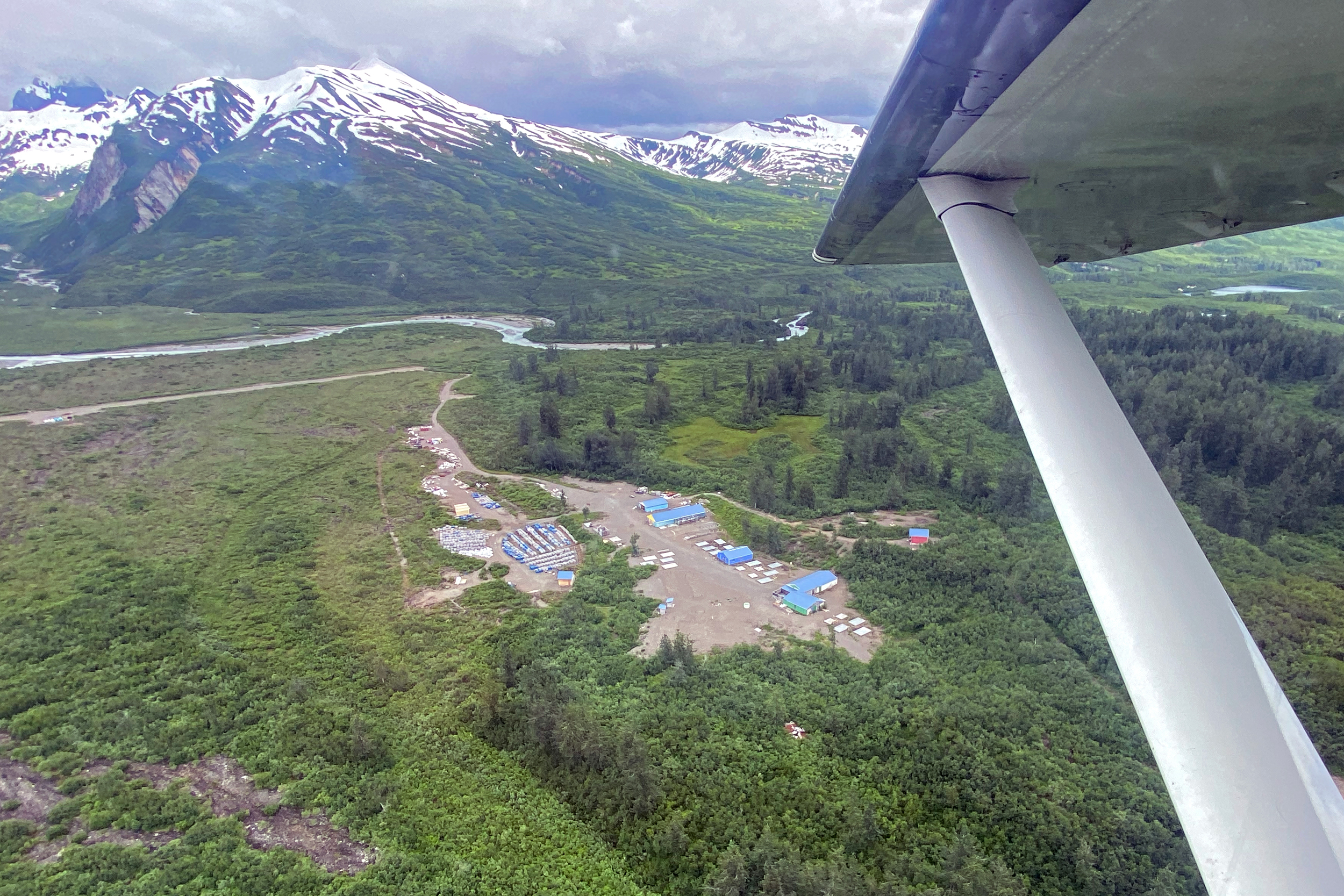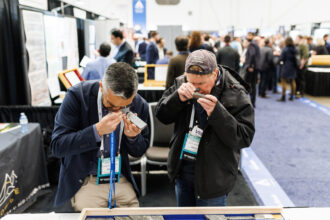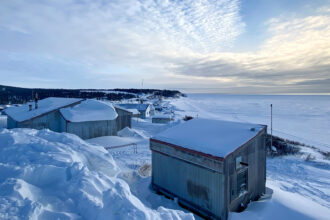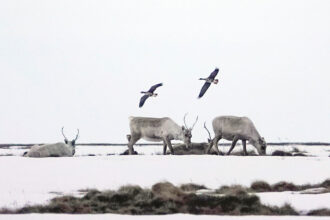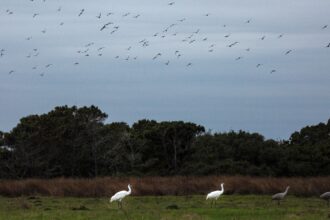Third in a three-story series published in partnership by Inside Climate News and Northern Journal.
COOK INLET, Alaska—High in a mountain valley on the far west side of this tidal inlet sits an unusual plot of land.
It’s a private parcel, with a gravel airstrip and four or five buildings that make up a small worker camp. But there are no towns in sight. Known as the Johnson Tract, the property is fully surrounded by the vast Lake Clark National Park—millions of wild acres marked by the broad white peaks of a volcano, sprawling glaciers and a muddy ocean coastline patrolled by brown bears.
Beneath the Johnson Tract lies a potential fortune. For decades, geologists have eyed gold, copper and zinc deposits thought to be worth billions of dollars. But they’ve never been tapped.
Now, amid surging gold prices and rising demand for metals like copper, the prospect is generating new excitement—and concern.
A prominent Alaska mining company is leasing the Johnson Tract from its Indigenous owners, and the property, some 125 miles southwest of Anchorage, has emerged as one of the most promising mining prospects in Southcentral Alaska.
But conservationists, commercial salmon fishermen and local lodge owners fear a mine, encircled by the federal protected area, could disrupt harvests and harm wildlife, including an endangered population of beluga whales.
Getting the Johnson Tract’s minerals to buyers will require trucking ore through a now-roadless corner of the national park to a future port.
Critics point out that the bay where the mining company, Contango Ore, Inc., wants to build a shipping terminal is an important winter habitat for the endangered belugas. Concern for the whales, among other objections, led mine opponents to sue federal regulators earlier this year over a permit that Contango received to build a short access road and expand an airstrip at the site.

Still, the project is advancing.
The land is owned by Anchorage-based Cook Inlet Region, Inc., or CIRI, one of 12 Indigenous-owned regional corporations created by Congress as part of a wider land claims settlement with Alaska’s Native people in 1971.
Contango, based in Fairbanks, started leasing the land from CIRI last year. With gold prices surpassing a record high of $4,000 per troy ounce this year, the mining company is already planning new roads and a tunnel to allow underground drilling on the Johnson Tract.
If a mine gets built, both Contango and CIRI’s nearly 10,000 Indigenous shareholders are poised to profit.
“The stars might be aligned right now,” said Margie Brown, a former CIRI president who also worked for the corporation’s lands department in the 1970s, when the company acquired the prospect.
The conflict reflects a deeper tension between two competing visions for Alaska—one of environmental preservation, the other of industrial development. Both visions extend back to a time when Congress set aside large tracts of the state’s wilderness for protection but also carved out areas for resource extraction, often intended to benefit Alaska’s Indigenous-owned corporations. Rooted in a series of landmark bills in the 1970s and 1980s, the Johnson Tract saga echoes some of the state’s other, higher-profile environmental battles, including over a mining road and oil development in the Arctic.
As Contango forges ahead, CIRI is asserting its right to profit from lands long intended for development, while opponents say that mining imperils a still-wild slice of Alaska.
Among critics of the mining project is Dustin Solberg, a commercial fisherman and environmental advocate who spends summers with his family setting nets for salmon along the beaches of Tuxedni Bay, about 10 miles northeast of the Johnson Tract. Contango could one day load ore onto ships from the same shore where Solberg and other fishermen haul fish out of the bay.
Standing on a quiet Tuxedni beach one day this summer with dramatic cliffs looming overhead, Solberg imagined mining trucks rumbling down a road nearby.
“I think it would irreversibly change this place,” he said.
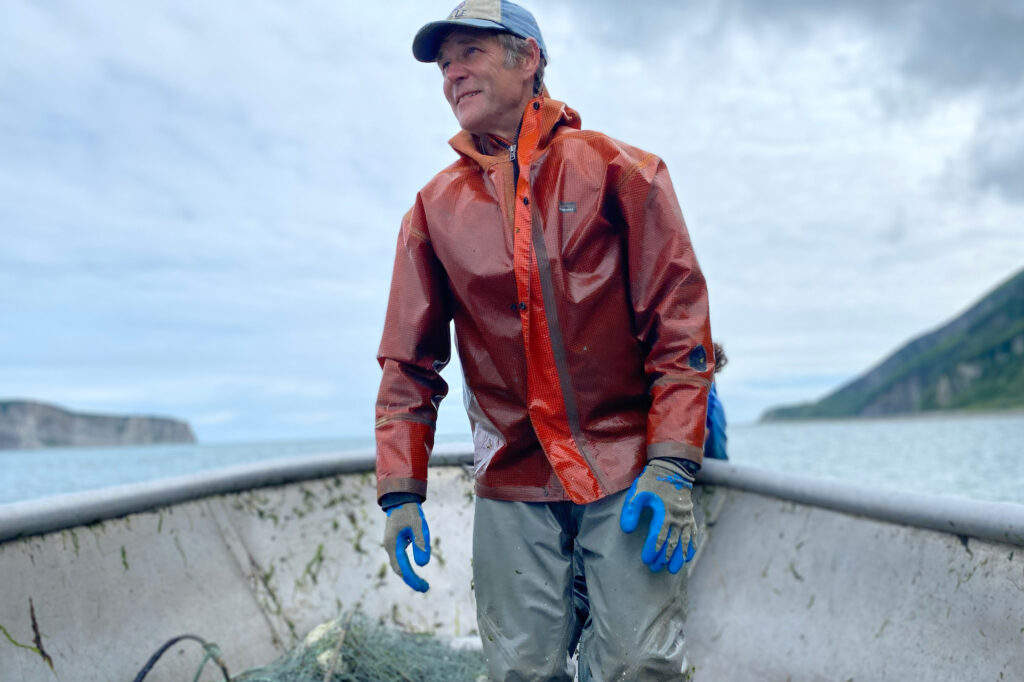
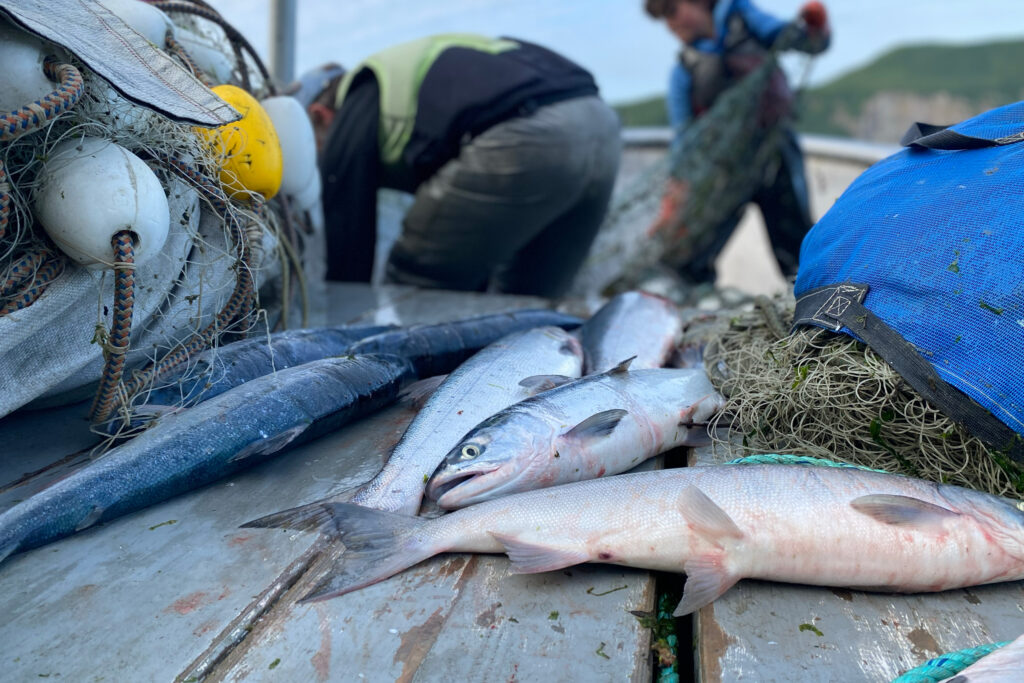
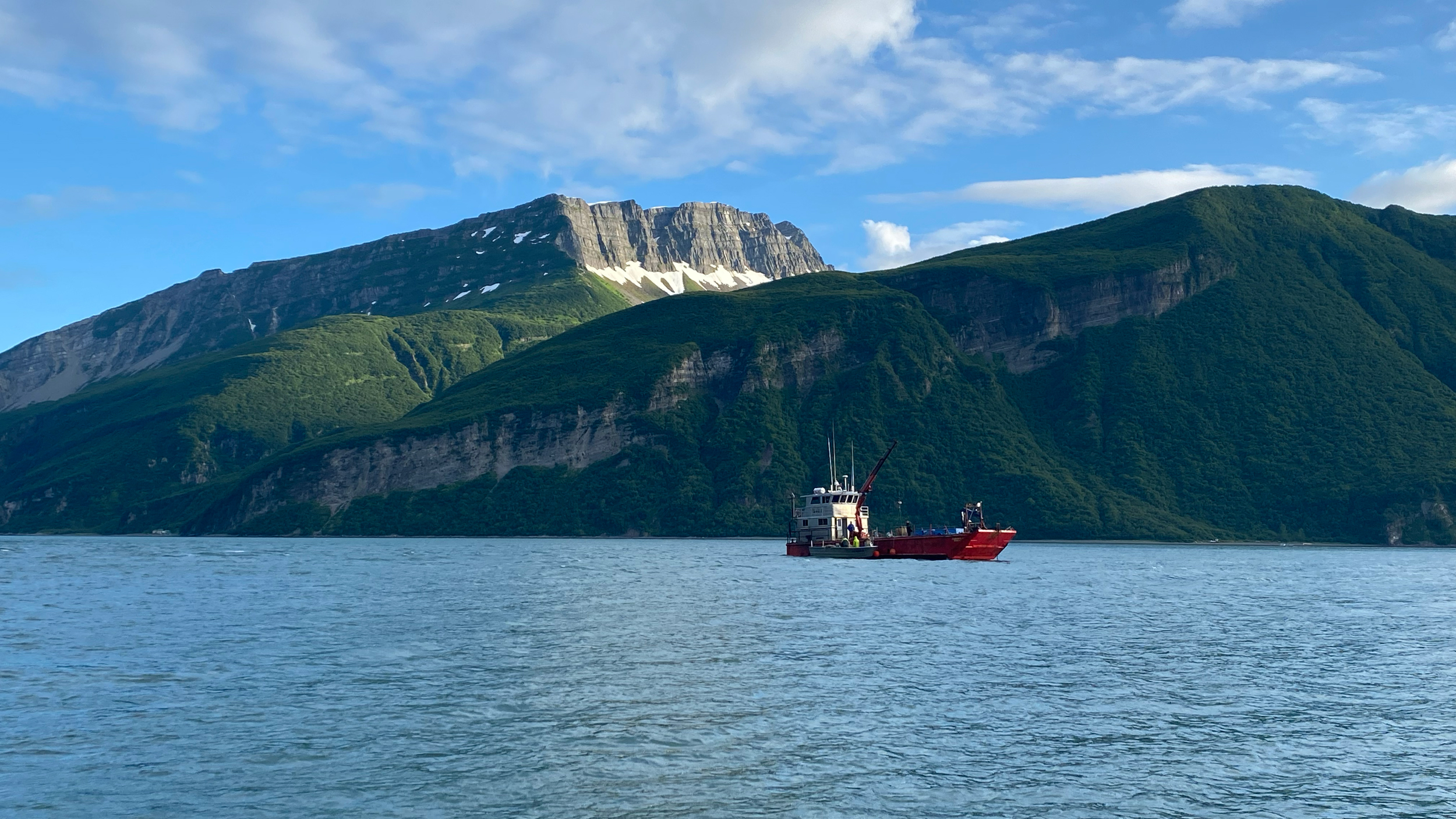
A Pivotal Deal
The Johnson Tract fight is rooted in the Alaska Native Claims Settlement Act.
Intended to resolve disputes over Indigenous land claims in Alaska, the federal legislation in 1971 established 12 for-profit Alaska Native corporations, each owned by Indigenous shareholders with ties to a region in the state. More than 200 other Indigenous companies tied to Native villages also formed.
The act promised to compensate the corporations with nearly a billion dollars and millions of acres of land, to be chosen by the companies’ elected leaders.
Those leaders quickly moved to obtain traditional hunting and fishing grounds and areas with cultural value, but they also sought land thought to be rich in minerals and other resources that they could convert into profits for shareholders.

In the Arctic, Native corporations acquired land with oil deposits. In Southeast Alaska, they logged vast stands of cedar and spruce.
But in CIRI’s region, around Anchorage and neighboring Cook Inlet, the pickings were sparse. The southcentral region is the state’s most populous, and by the time of the settlement, military bases and wildlife refuges had been set aside by the federal government, prime real estate was in the hands of private developers and other parcels had been snatched up by the state.
“You just had so much pressure for lands within the Cook Inlet region,” said Brown, who now serves on CIRI’s board.
The corporation’s leaders argued that they were largely left with glaciers and mountain ridges — dim prospects for its shareholders.
Two years after Congress approved the settlement, CIRI sued the U.S. interior secretary, arguing that his agency had not made adequate property available for CIRI to develop. Tense negotiations ensued, producing a sprawling agreement between CIRI and the state and federal governments: the Cook Inlet Land Exchange.
The deal called for CIRI to give up half the property around Cook Inlet that the corporation was entitled to under the original settlement, Brown said. Some of that foregone land would be folded into Lake Clark National Park and Preserve when Congress created it a few years later.
In return, CIRI would be able to acquire land elsewhere in Alaska, and even outside the state.
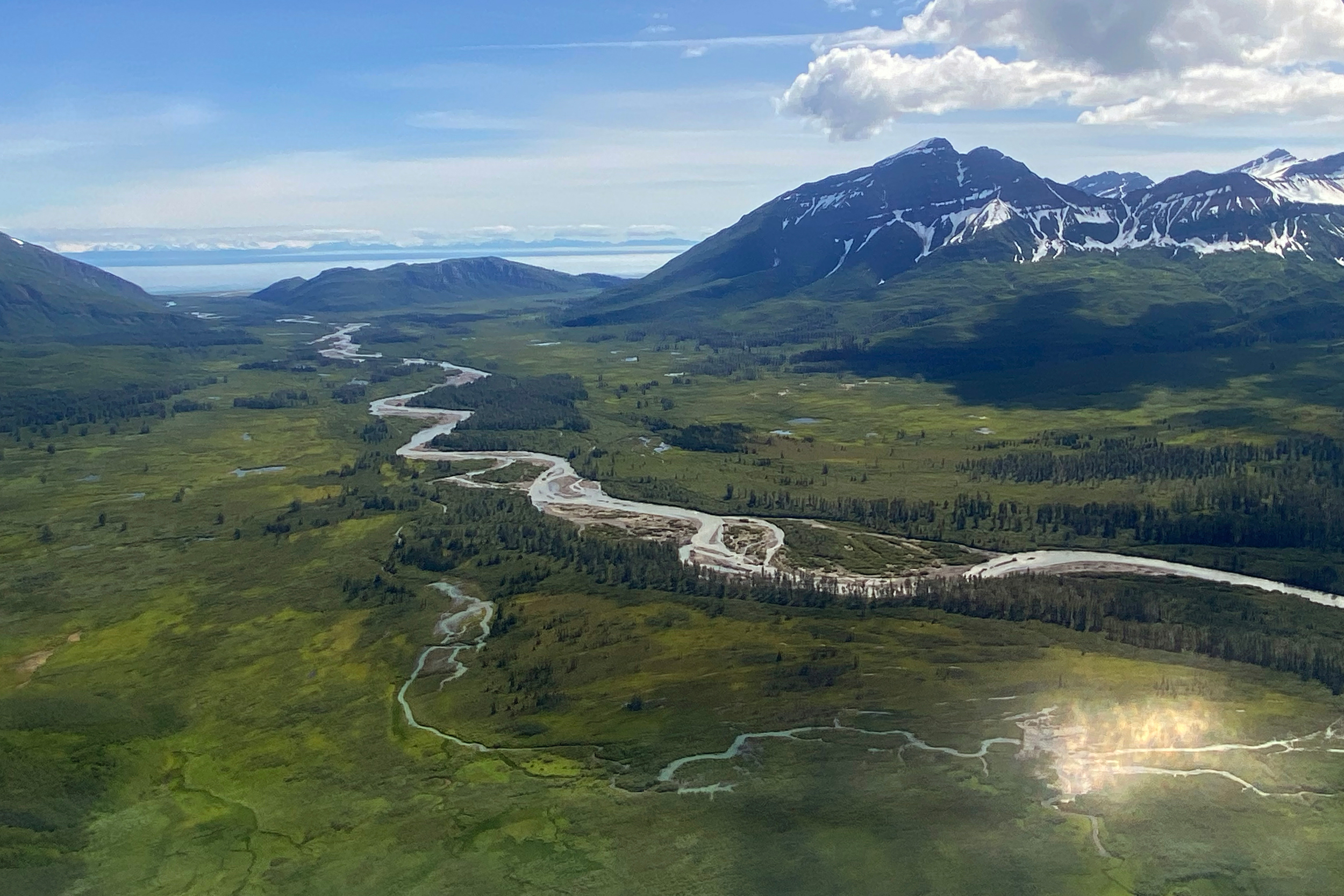
The deal also allowed CIRI to pick up some key assets around Cook Inlet, including the Johnson Tract, which the corporation chose specifically for its mineral potential. CIRI’s early leaders viewed the land swap as a hard-fought compromise, and Brown called the Johnson Tract “key to the bargain.”
“The ability to use the land in the way Congress intended is something that needs to be preserved,” she said. “It’s unfortunate that as we move further and further from congressional intent, it’s harder and harder for people to remember that.”
The Johnson Tract is really two adjacent parcels, totaling about 33 square miles. CIRI—now a huge business, with nearly $1 billion in assets—owns the minerals beneath both parcels, and the surface of the south tract, where the main deposit sits. The federal government retained surface ownership of the north tract.
Citing a provision in the land exchange, the Department of Interior earlier this year granted CIRI the rights to transport ore through the park, with certain restrictions to limit environmental impacts. CIRI and Contango have not formally proposed building a haul road and port, which would require additional permits.
An “Awesome” Deposit
Soon after CIRI acquired the Johnson Tract, the corporation began scouring it for more minerals, seeking enough to justify building a mine.
In the early 1980s, CIRI partnered with Anaconda Minerals, a subsidiary of the global oil giant ARCO, to evaluate the prospect.
Anaconda found promising amounts of gold, zinc and copper and at one point—given the area’s prolific amount of snow—envisioned an underground tunnel or aerial tram to move ore the dozen miles from a mine to a port on the coast. But Anaconda went out of business. And aside from another unsuccessful effort to develop the Johnson Tract in the 1990s, the land sat largely dormant until 2019.
That year, CIRI signed a lease with a Vancouver-based mineral exploration company, which quickly handed over the operations to a spinoff firm, HighGold Mining Inc. HighGold spent tens of millions of dollars on exploration and drilled more than 150 core samples before Contango bought the company last year in a deal worth some $35 million.
The Johnson Tract appealed to Contango’s chief executive, Rick Van Nieuwenhuyse, because it seemed to be a good fit for the company’s unconventional development model, which involves shipping raw ore to a processing plant off site, rather than crushing and processing ore next to the deposit, as most mines do.
The approach avoids some of the more expensive and hard-to-permit components of a typical mine, like a mill and a big waste pond. In theory, it keeps construction costs low and makes permitting easier, Van Nieuwenhuyse said. But shipping unprocessed ore also risks higher transportation costs, so Johnson Tract’s close proximity to the ocean and shipping routes made it attractive.
“It’s an awesome deposit,” Van Nieuwenhuyse said, citing the prospect’s high ratio of valuable minerals to rock and its thickness, which he expects will make the mining process more efficient.
Van Nieuwenhuyse is a veteran of Alaska’s mining industry, having worked over the past four decades on some of the state’s most prominent early-stage projects.
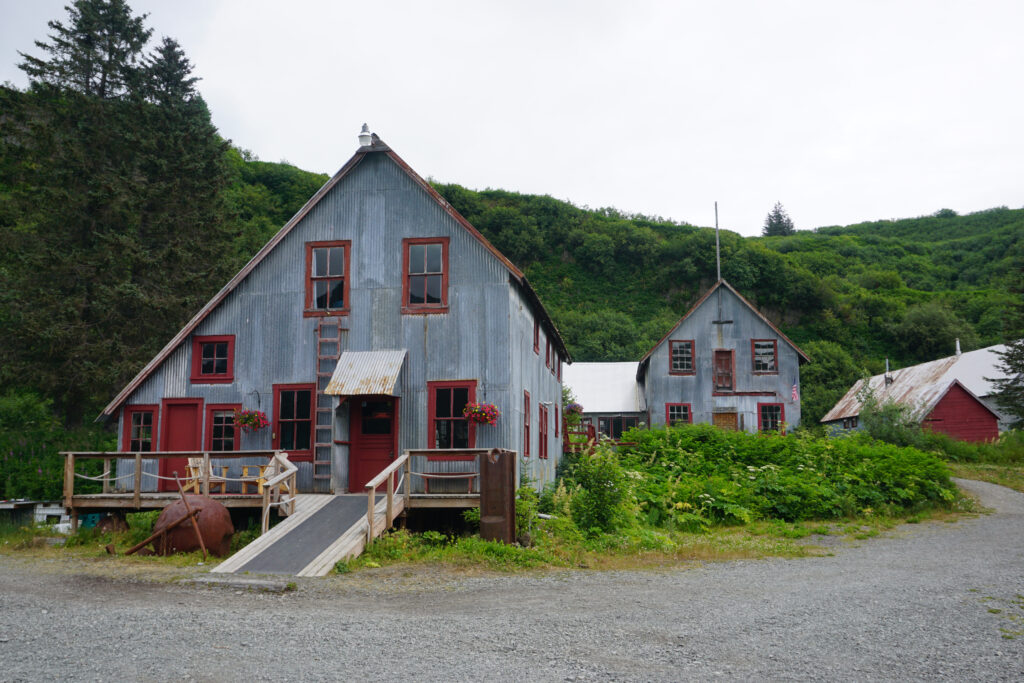
He played major roles in advancing Western Alaska’s Donlin project — the state’s biggest proposed gold mine — and high-profile prospects in Northwest Alaska at the end of the controversial proposed Ambler Road. He also led development of the Rock Creek gold mine near Nome, which closed in 2008 soon after opening amid a slew of challenges.
At Contango, where Van Nieuwenhuyse was named chief executive in 2020, he partnered with the multinational Kinross Gold Corp. to spearhead the construction of Alaska’s first large mine in more than a decade, a project in the Interior called Manh Choh.
Unlike that open-pit mine, Johnson Tract would be an underground operation. Several years of exploratory drilling, permitting and engineering are expected before a final decision on building a mine, Van Nieuwenhuyse said.
The mine, according to Contango’s preliminary plans, would operate for seven years and would be small compared to other major Alaska mines. Contango would share royalties on mineral sales with CIRI, which has an option to buy as much as a 25 percent stake in the mine.
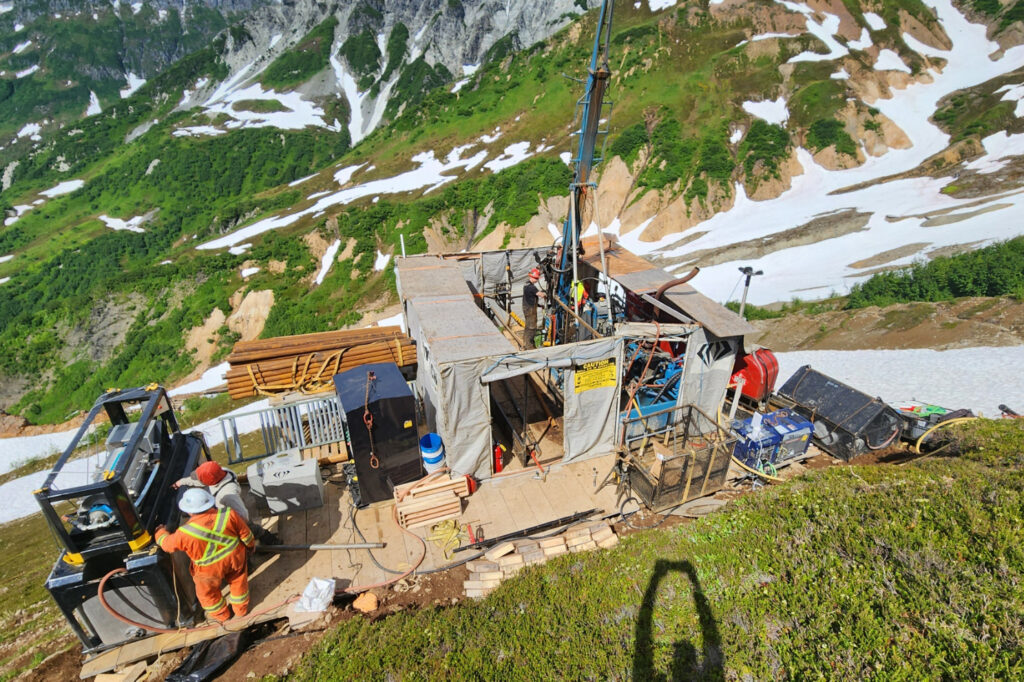
CIRI declined interview requests about the Johnson Tract, and the corporation’s executives have made few public statements about it.
The project “presents an opportunity to responsibly develop mineral resources to benefit our shareholders while respecting the environment and preserving the land,” CIRI said in a brief update last year. “The Johnson Tract project reflects decades of hard work to build a foundation of self-determination and financial stability.”
“We’re Here Because it’s Beautiful”
Dustin Solberg, the fisherman and mine opponent, was motoring to a net he’d set on the west side of Tuxedni Channel one afternoon last summer when he spotted a brown bear on a rocky beach ahead.
“I think it smells the fish, Dad,” 12-year-old son and deckhand Leif Solberg called out.
Neither father nor son seemed particularly concerned. The area has so many beach-loving bears that it draws tourists from around the world for viewing and photography.
Far more worrisome to the elder Solberg is the future of the beach where the bear was roving—near a site that Contango is considering as a shipping port.
Solberg, his family and others who fish in the channel each summer have growing concerns about Contango’s vision. They fear that a new road and industrial dock, and the traffic and noise from trucks and ships, would mar the wild character of the bay and the park around it.
As Solberg looked across the channel, it was remarkably quiet, aside from a few fishing skiffs and an occasional float plane that landed at a bear-viewing lodge on Chisik Island. Other than the lodge and a few fishing cabins, Chisik is a federally designated wilderness area, home to a prolific seabird colony.
A dozen or so crews fish commercially for salmon in the bay. Two or three times a week, from June through August, they set, pick and pull nets along pebbly beaches on either side of Tuxedni Channel, with fishing periods that can last 12 hours or more.
It’s hard labor, Solberg said, but the season moves at a slower pace than Alaska’s bigger-volume salmon fisheries, like Bristol Bay, where boats sometimes work 24-hour shifts.
“If you wanted to make money, you would fish somewhere else,” said Ann Harding, Solberg’s wife. “We’re here because it’s beautiful.”
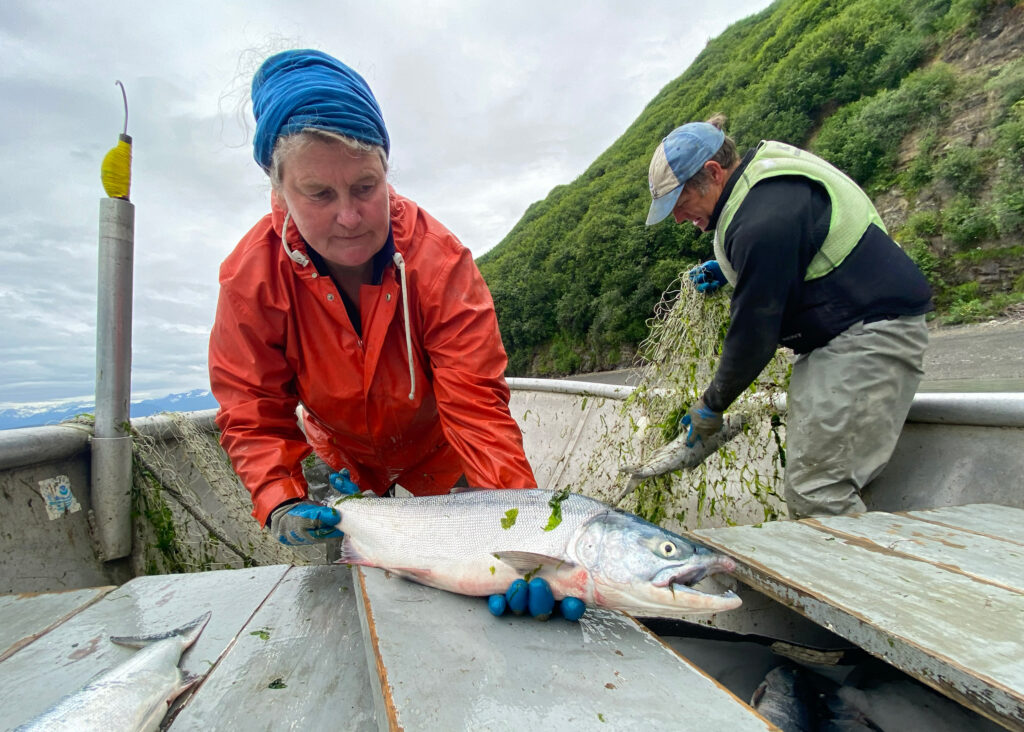
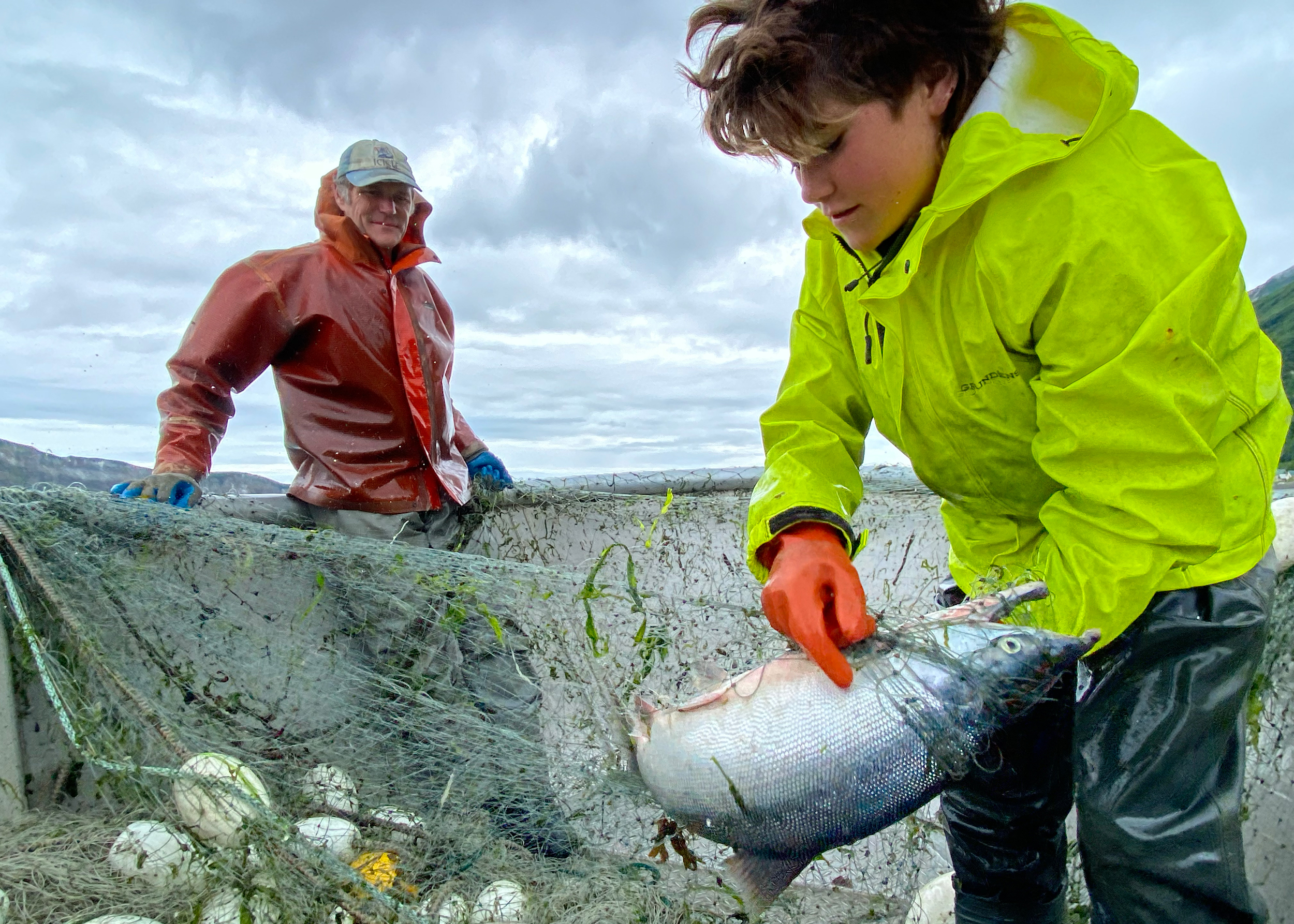
The area has “phenomenal” mountains and a striking density of birds and bears, added Harding, a bird biologist who sometimes fishes alongside Solberg.
The family uses a cabin a mile or two down the shoreline from where the bear had been walking. It’s a small plywood structure beneath an A-frame roof, surrounded by an electric fence to keep away curious ursine visitors. The cabin is about a hundred feet back from the water and set fully within Lake Clark National Park.
Solberg and Harding bought the structure several years ago. They don’t have title to the land beneath it or a formal permit from the park service. But the cabin existed before the park was established, and past owners had an informal arrangement with federal officials to keep using it, Solberg said.
The cabin now sits in an easement that the Department of Interior earlier this year granted CIRI for a mining port. Solberg doesn’t think his small business will amount to much of an obstacle.
“This is just a little shack that doesn’t really compete with the value of an operation like that,” he said, referring to the mining plans. “So, I don’t expect this to get in the way of anything.”
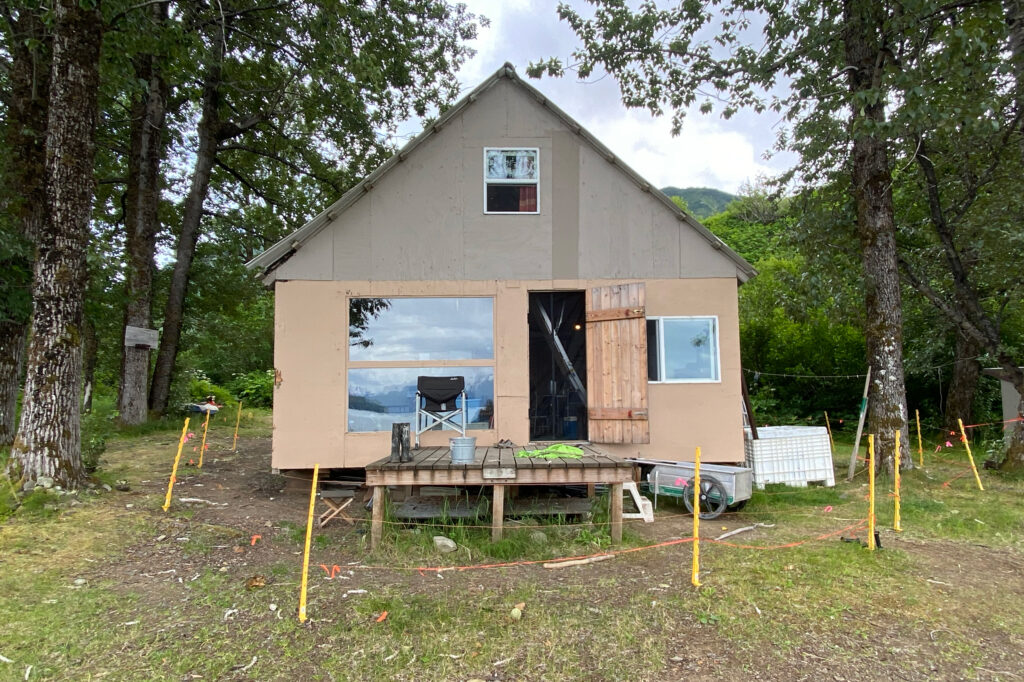
CIRI and Contango have not made a final decision about where to put the port, and a CIRI environmental document said last year that there is “considerable uncertainty” about future construction.
Van Nieuwenhuyse, the Contango mining executive, said his company recognizes the rights of the setnetters, and he believes a mine can co-exist with the fishery.
“I would ask that everybody recognize CIRI’s rights as well,” he added.
Where Belugas “Hang Out”
As it gathers pace, Contango is facing opposition not just from the commercial fishermen but also from conservation groups and some tribal governments in the region.
A national group, the Center for Biological Diversity, along with the Homer-based nonprofit Cook Inletkeeper and the Chickaloon Village Traditional Council, a tribal government, are suing the U.S. Army Corps of Engineers for issuing a key permit to Contango.
Several tribal leaders also have raised concerns about the project and have asked the Trump administration to suspend the permit.
A core concern among those opponents is that a mining operation could threaten Cook Inlet’s beluga whales, which are treasured by many Anchorage residents and local wildlife viewers.
The inlet’s belugas—which are genetically distinct from other beluga populations—once numbered around 1,300 animals, but their numbers sharply declined in the 1990s. They were listed as endangered in 2008 and still have not significantly recovered. The population now stands at some 330 whales.
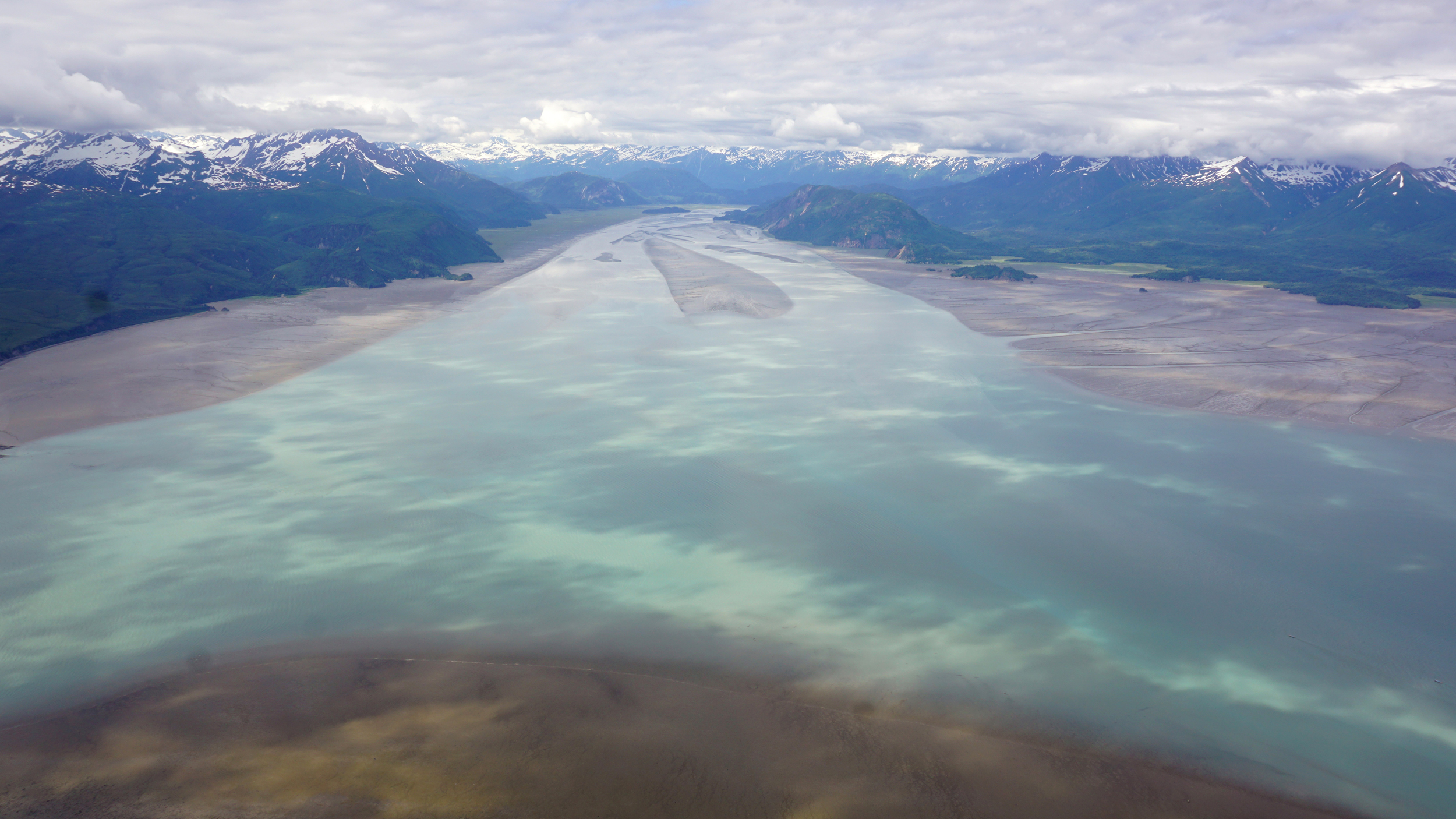
During the summer, the belugas are commonly spotted feasting on fish at the mouths of salmon-bearing streams near Anchorage. Where they go in winter has been a mystery.
But last year federal scientists announced a big discovery in a study that analyzed underwater sound recordings.
The researchers, affiliated with the National Oceanic and Atmospheric Administration, identified Tuxedni Bay as the only known foraging ground for the whales between late fall and late spring. They warned that human-caused noise is a “key threat” to the belugas, which use sound to navigate and communicate, and that industrial activity could affect the quality of the whales’ habitat.
NOAA Fisheries, which led the study, declined interview requests. One of its scientists, in a press release announcing the study, said that “maintaining the status quo” may be all that’s needed to help the beluga population recover.
This story is funded by readers like you.
Our nonprofit newsroom provides award-winning climate coverage free of charge and advertising. We rely on donations from readers like you to keep going. Please donate now to support our work.
Donate NowAs Contango studies sites for a port, it’s now funding a new beluga survey by biologists working for the state of Alaska, which has often been more friendly to the mining industry than the federal government.
The survey is focused on the narrow channel where Contango is considering shipping ore, while the NOAA-led study looked more broadly at the 10-mile-long Tuxedni Bay.
“We want to know where the belugas like to hang out,” Van Nieuwenhuyse said.
One of the loudest voices advocating for the belugas and against development at the Johnston Tract is Cooper Freeman, a Homer resident and the Alaska director at the Center for Biological Diversity. The center is a 35-year-old nonprofit that aims to protect wildlife and ecosystems across the country, and it’s a participant in nearly a dozen active lawsuits in Alaska’s federal court.
In an interview, Freeman acknowledged CIRI’s right to the minerals at the Johnson Tract. But he noted that federal environmental laws still apply and argued that CIRI does not have an “absolute right” to build a mine.
In his view, the area is too ecologically rich—with its important beluga habitat and high density of brown bears, seabirds and shorebirds—to risk.
“It’s just an incredibly, biologically, intensively rich and completely intact area—one of the only remaining places like it in all of Cook Inlet,” he said. “I don’t think there’s any amount of money that’s worth destroying this place.”

There are no towns within 40 miles of the Johnson Tract—just roadless mountains, glaciers, forests and streams.
Aside from seasonal fishermen, CIRI and Contango’s neighbors include Silver Salmon Creek Lodge, a bear-viewing and sport-fishing business that’s near the mouth of the Johnson River, a dozen or so miles downstream of the mineral deposit.
Longtime lodge owners David Coray and Joanne Edney have kept loose tabs on the prospect for decades and have grown more concerned as Contango’s project advances.
In a recent interview, Coray and Edney said they’re worried that a mine could pollute the Johnson River and disrupt bear habitat.
“We understand their interest, and we understand their rights,” Edney said of CIRI and Contango. But a mining operation could come into “direct conflict” with her family’s business, she said.
CIRI declined to respond to questions about opposition to the project, and about how it’s gauging the views of its shareholders, some of whom have spoken out against it.
Van Nieuwenhuyse said Contango is committed to protecting wildlife.
“We’ll develop this deposit with minimal impacts to the environment, which we recognize as pristine,” Van Nieuwenhuyse said. “We’re all from Alaska. We enjoy the outdoors. That’s why we all became geologists.”
For Solberg, the fisherman, the convergence of competing interests in the area is “endlessly fascinating—and really complicated and really unfortunate.”
In a conversation after the fishing season, Solberg acknowledged a tension between CIRI’s rights to the Johnson Tract’s minerals and the spectre of a mine transforming the landscape and bay that his family has come to know and love.
Solberg said he feels “really torn” about the issue and that he respects CIRI’s land claims. But as one of the few Alaskans who spends long stretches of time in Tuxedni Bay, he feels obligated to speak in defense of its wildness and beauty.
“I just want decisionmakers to have their eyes wide open,” he said. “And to realize what’s at stake.”
This story was supported by a grant from the Alaska Center for Excellence in Journalism.
About This Story
Perhaps you noticed: This story, like all the news we publish, is free to read. That’s because Inside Climate News is a 501c3 nonprofit organization. We do not charge a subscription fee, lock our news behind a paywall, or clutter our website with ads. We make our news on climate and the environment freely available to you and anyone who wants it.
That’s not all. We also share our news for free with scores of other media organizations around the country. Many of them can’t afford to do environmental journalism of their own. We’ve built bureaus from coast to coast to report local stories, collaborate with local newsrooms and co-publish articles so that this vital work is shared as widely as possible.
Two of us launched ICN in 2007. Six years later we earned a Pulitzer Prize for National Reporting, and now we run the oldest and largest dedicated climate newsroom in the nation. We tell the story in all its complexity. We hold polluters accountable. We expose environmental injustice. We debunk misinformation. We scrutinize solutions and inspire action.
Donations from readers like you fund every aspect of what we do. If you don’t already, will you support our ongoing work, our reporting on the biggest crisis facing our planet, and help us reach even more readers in more places?
Please take a moment to make a tax-deductible donation. Every one of them makes a difference.
Thank you,

